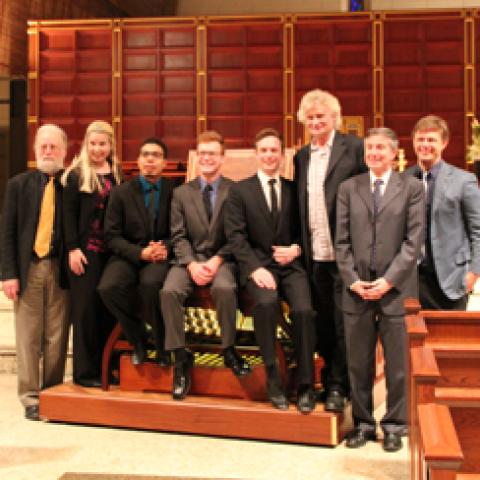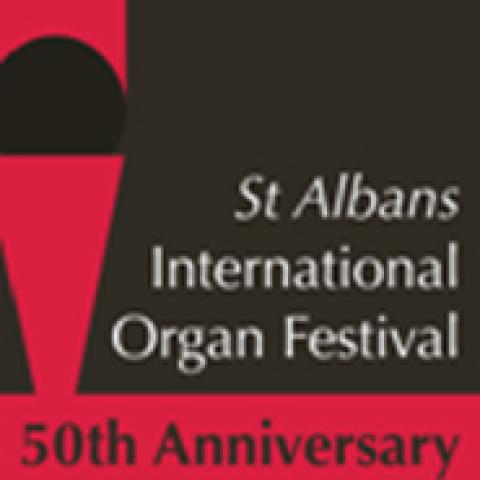Part two of two

National Competition in Organ Improvisation
The ninth National Competition in Organ Improvisation was held at St. James Episcopal Cathedral in Chicago. Five semi-finalists were chosen from 19 preliminary round recordings. Judges for the preliminary round were Justin Bischof, Marianne Ploger, and Bruce Shultz. Five semi-finalists resulted from the recorded round: Steven Ball, Vincent Carr, John Karl Hirten, David J. Hughes, and Tom Trenney. Judges for the semi-final and final rounds were James Biery, Sophie-Véronique Cauchefer-Choplin, and Hans Davidsson. Richard Proulx composed original themes for the competition.
The three finalists chosen to compete in the final round on Monday evening, July 3, were Vincent Carr, John Karl Hirten, and Tom Trenney. The first prize of $2,000, provided by the Holtkamp Organ Company, was awarded to Tom Trenney, director of music and organist at First Presbyterian Church, Birmingham, Michigan. The second prize of $1,500, provided by Dobson Pipe Organ Builders, was awarded to Vincent Carr, a graduate organ student at Yale University’s Institute of Sacred Music where he studies with Martin Jean. An audience prize of $1,000 provided by David and Robin Arcus and McNeil Robinson was awarded to Tom Trenney.
A 30-page souvenir booklet, which included a history of the NCOI competition, competition criteria, semi-finalists’ biographies and photographs, judges for all rounds, specifications of the Austin/Skinner organ at St. James Cathedral, statements from the prize donors, and lists of NCOI committees, previous judges, and composers was made available to those attending the semi-final and/or final rounds. This booklet also included 14 pages of themes used in past competitions.
National Young Artists Competition in Organ Performance
On Sunday, July 2, three organists competed in the final round of the National Young Artists Competition in Organ Performance at St. Paul’s United Church of Christ: Robert Horton, Bálint Karosi, and Scott Montgomery. Each performed Bach’s
First place (The Lilian Murtagh Memorial Prize: $2,000 cash award and career development assistance from Karen McFarlane Artists, Inc., and a CD recording for the Pro Organo recording label) went to Scott Montgomery, director of music and organist at Holy Cross Catholic Church in Champaign, Illinois, and a master’s student of Dana Robinson at the University of Illinois. Second place ($2,000 provided by John-Paul Buzard Pipe Organ Builders): Bálint Karosi, a native of Budapest, Hungary, and a student of James David Christie at the Oberlin Conservatory. Third place ($1,000 provided by the Noack Organ Co. Inc.): Robert Horton, assistant professor of music at Dordt College, Sioux Center, Iowa. Audience Choice prize: Scott Montgomery ($500 provided by Martin Ott Pipe Organ Company Inc.). The Reger Prize: Robert Horton ($500 provided by Jim Zinkhan and Heather Holowka).
Judges for the final round were Christa Rakich, Charles Tompkins, and Christopher Young.
Recitals
St. Ita’s RC Church was the site of the recital by Sophie-Véronique Cauchefer-Choplin on Wednesday, July 5. Cauchefer-Choplin is titular at St. Jean Baptiste de la Salle in Paris and co-titular at St. Sulpice, Paris. Her program included Suite pour Orgue, Bédard; Prelude (from Suite, op. 5), Duruflé; Mélodie Intérieure, Grunenwald; Résurrection (from Symphonie-Passion), Dupré; and an improvisation on a submitted theme (“Chicago”). The elegant French Gothic architecture of the church was the perfect setting for Cauchefer-Choplin’s elegant playing, and the Opus 2918 Wicks organ (1949–50), rebuilt in 2002–03 by H. A. Howell, provided the necessary color and brilliance for the program of French works. Passion and delicacy were evident in pleasing proportion throughout the program, and the improvisation on the tune “Chicago” demonstrated technical mastery and structural coherence, and brought the audience to its feet.
San Diego Civic Organist Carol Williams played an unusual program at St. Vincent de Paul Church on Thursday, July 6. Beginning with a virtuosic performance of the Liszt Prelude and Fugue on B.A.C.H., in a syncretic version by Jean Guillou, the artist then offered the Six Sketches on Children’s Hymns, op. 481, by Barrie Cabena, winner of the Holtkamp-AGO Award in Organ Composition, The Brothers Gershwin arranged by Howard Cable, and Toccata “Store Gud, vi lover deg” by Iver Kleive.
A veteran of numerous performances at the outdoor Spreckels Pavilion, as well as recitals worldwide, Williams was right at home with the eclectic program, playing with brilliance in the Liszt, tenderness in the Cabena, playfulness in the Gershwin, and sheer enjoyment in the Kleive toccata. The venerable 1901 Lyon & Healy organ has been under the care of Alfred J. Butler of New York City.
Wolfgang Seifen played an all-improvisation concert on the Opus 2207 Reuter organ (III/64) at Trinity United Methodist Church in Wilmette on Wednesday, July 5. The program consisted of an improvised Symphony in Six Movements based on submitted themes. Seifen amazed the audience with his phenomenal technique, even combining the submitted themes with patriotic tunes in honor of the recent holiday. Listeners praised his phenomenal technique, energy, and command of the organ, showing the wide variety of color in the recent installation. He was given an enthusiastic standing ovation.
The Morrison Duo, Jeannine Morrison, piano, and Alan Morrison, organ, played a recital at College Church Wheaton (Schantz Opus 2012, III/54), on Thursday, July 6. The program included Flying Fingers, Johnny Costa; Sinfonia, op. 42, Dupré; Newmark Variations and Mountain Music, Harold Stover; and Variations on a Theme by Paganini, Lutoslawski. One heard many comments on Mrs. Morrison’s flawless piano technique and the overall polished performance of the duo in what proved to be unfamiliar repertoire for most convention-goers.
—Jerome Butera




